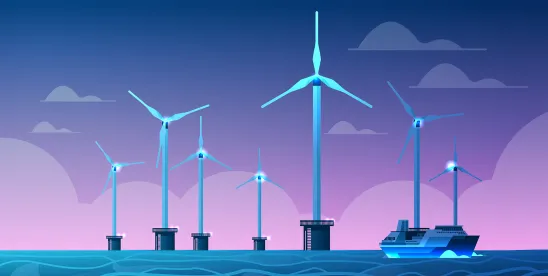California currently deploys almost 35 GW of renewable energy but expects another 148 GW of renewables will be needed to meet the state’s overarching 2045 clean energy goals. To fill this gap, California expects offshore wind to contribute significantly and is steadily laying out the path to bring offshore wind to market.
The California Public Utilities Commission’s Proposed Order
The California Public Utilities Commission (“CPUC”) is authorized to order the procurement of resources by electrical corporations, electric service providers and community choice aggregators as part of its Integrated Resource Planning (“IRP”) Process. Under Assembly Bill 1373 (“AB 1373”) enacted in 2023, the CPUC also may identify procurement needs from long lead-time resources through a central planning process. Through this process, the CPUC may request that the California Department of Water Resources (“DWR”) procure long lead-time resources on behalf of entities included in the CPUC’s IRP. AB 1373 also required the CPUC to make an initial “need determination” for procurement using a centralized procurement mechanism. See our prior blog post for an overview of the AB 1373 process.
In the latest major step to create a pathway for California offshore wind, a proposed decision published on July 19, 2024 by the CPUC promises to commence the state’s long lead-time resource procurement process and facilitate the procurement of up to 7.6 GW of offshore wind energy. The proposed decision includes the initial need determination and recommends at least three rounds of offshore wind procurements starting in 2027. If the CPUC adopts the proposed decision, up to 7.6 GW of offshore wind energy could be procured on behalf of California’s retail customers and load-serving entities. Note that the proposed decision is not yet final but could be adopted as soon as the CPUC’s meeting on August 22, 2024.
In the proposed decision, the CPUC expressed its desire to signal “strong interest in developing the [offshore wind] resource and investing up front in order to achieve economies of scale that will be necessary to realize the full benefits . . . .” Further, the CPUC reasoned, the 7.6 GW level of procurement achieves a balance between the state’s needs and the maximum lease space available to develop offshore wind projects.
Charting a Path for California Offshore Wind Development
The need determination in the CPUC’s proposed decision is the latest in a series of milestone efforts by California regulators to bolster the state’s nascent offshore wind industry. See our prior blog post for an overview of the earlier steps in this process. At its July 10, 2024, meeting, the California Energy Commission (“CEC”) adopted and published its Final Commission Report on California’s Offshore Wind Energy Strategic Plan (“Final Report”), as directed by Assembly Bill 525 (“AB 525”). The CEC issued its Final Report in three volumes: Volume I as an overview, Volume II as the main report and Volume III as technical appendices. These three volumes will guide offshore wind development in California by outlining opportunities for and hurdles to offshore wind in federal waters off the state’s coast. The Final Report, in combination with the CPUC procurement authority outlined in the proposed decision, will serve as the blueprint for California’s offshore wind industry.
The CEC’s Final Report details the many opportunities and hurdles to California reaching its offshore wind-specific goals of 2 to 5 GW by 2030 and 25 GW by 2045, outlining the necessary transmission investments, port infrastructure upgrades, power procurement options, workforce development needs, expected benefits from development, impact mitigation strategies and proactive stakeholder engagement processes.
Transmission Infrastructure Investments
Before the CEC’s Final Report, California bolstered its transmission planning processes with a December 2022 memorandum of understanding between the California Independent System Operation (“CAISO”), the CPUC and the CEC. Additionally, on May 23, 2024, CAISO approved a 2023-2024 Transmission Plan that included roughly $4.6 billion in new transmission projects necessary to bring North Coast offshore wind development to load.
The Final Report’s assessments conclude that multiple phases of significant investments are necessary for transmission, interconnection and distribution infrastructure to accommodate the planned offshore wind development. Due to the North Coast’s relatively small local loads and lack of interconnection with major existing transmission paths, the Final Report reviews studies that consider five offshore wind areas off northern California and southern Oregon, and various potential transmission scenarios ranging from 7.2 to 25.8 GW.
Overall, the CEC is planning for interregional transmission that leverages overland transmission, subsea transmission, high voltage alternating current and direct current options. The Final Report also projects that emerging technologies like dynamic cables, floating substations and direct current circuit breaks will become more commercially viable as development continues. However, the Final Report predicts a need for networked or backbone transmission systems to efficiently interconnect all projected developments with minimized environmental impacts. Going forward, the CEC, CPUC and CAISO intend to continue to conduct transmission corridor assessments, explore competitive transmission solicitations, implement interconnection process improvements and streamline permitting for transmission development by eliminating duplicative determinations and environmental reviews.
The Importance of Ports
Because no single port can serve all California offshore wind industry needs, the CEC outlines a coordinated multi-port strategy using 16 large and 10 small ports over the next decade. The Final Report identifies the need for three to five 80-acre sites for staging and integration, 12 sites for manufacturing and fabrication and nine to 16 berths for operations and maintenance activities. However, the CEC believes that California must prioritize developing staging and integration sites as well as operations and maintenance sites – over manufacturing and fabrication sites – because some components can be imported.
According to the Final Report, the Ports of Humboldt, Long Beach and Los Angeles will be the most appropriate locations for staging and integration, with Humboldt and Long Beach actively working to meet the immediate needs of the industry. In total, $11 to $12 billion of investment in port infrastructure upgrades is needed to accommodate the state’s 2045 goals.
Workforce Development
Workforce development will require partnerships between industry, training institutions, government entities and the community, the Final Report explains. The Final Report also notes that the skilled workforce necessary to meet California’s offshore wind demands requires six main job categories: technicians and trades, construction and assembly, maritime and port workers, engineers, management, and administrative and clerical. Safety is a top priority across all job and skill categories. Short-term workforce development will center on trade, technician and construction skills. Long-term development will focus more on a robust supply chain and manufacturing workforce. Throughout the entire workforce development process, the CEC plans to support underserved or potentially impacted communities in many ways.
Economic and Community Benefits
The Final Report expects numerous short- and long-term economic benefits to result from California’s growing offshore wind industry. By 2045, the CEC estimates offshore wind to generate over $5 billion in state-level gross domestic project, with an additional $1.2 billion in labor income and $385 million in fiscal revenue. Should California adopt policies to properly incentivize in-state supply chain capacity, the CEC believes these projections could increase by 20 percent.
The Final Report estimates that the Port of Humboldt will gain 500 annual short-term jobs by 2030 and 14,000 annual long-term jobs by 2045 from necessary port infrastructure investments and workforce development. Moreover, based on 1 GW of development planned at Morro Bay, the CEC estimates 13,000 full-time jobs, $1.09 billion in earnings, $3.23 billion in economic output and $1.57 billion in gross domestic product. Should development grow to 10 GW at Morro Bay, the CEC projects over 169,000 jobs and $45 billion in economic benefits.
Impact Mitigation
California will implement comprehensive monitoring plans and adaptive management strategies to ensure the protection of marine resources during development. The Final Report proposes many specific strategies to protect marine resources including siting surveys, identification of at-risk resources, habitat restoration, compensatory mitigation funds, construction area monitoring, use of shielding on subsea cables, anchoring combined with best available mooring systems and establishing robust baseline date to inform scientific monitoring of potential environmental changes through development.
Proactive Stakeholder Engagement
The Final Reports explains that additional controls will be implemented to protect tribes, fishing communities and national defense stakeholders. For tribes, CEC plans to facilitate meaningful consultation with tribal representatives. For fishing communities, the Condition 7c California Offshore Wind and Fisheries Working Group is working to develop strategies to avoid or minimize impacts. As required by California Senate Bill 286, the working group will adopt specific strategies by May 1, 2026 that will outline communications plans with fishing communities in areas potentially affected by development, maximize continued access for fishermen to productive fishing areas, develop a template community benefit agreement for fishermen and consider opportunities to compensate fishermen for economic losses. For national defense stakeholders, mitigation strategies will focus on avoiding conflicts. This will be achieved, according to the Final Report, through coordinated communication plans between state agencies, the Office of Secretary of Defense Siting Clearinghouse, the Bureau of Ocean Energy Management and developers.
The Path Forward
In sum, the CPUC’s pending need determination and CEC’s Final Report bring clearer focus to California’s offshore wind energy strategy, but California will need to continue these efforts to ensure the major elements of offshore wind energy industry can come together to support the State’s clean energy goals.
*Bracewell summer associate Max Galatas provided invaluable assistance with this blog.





 />i
/>i

